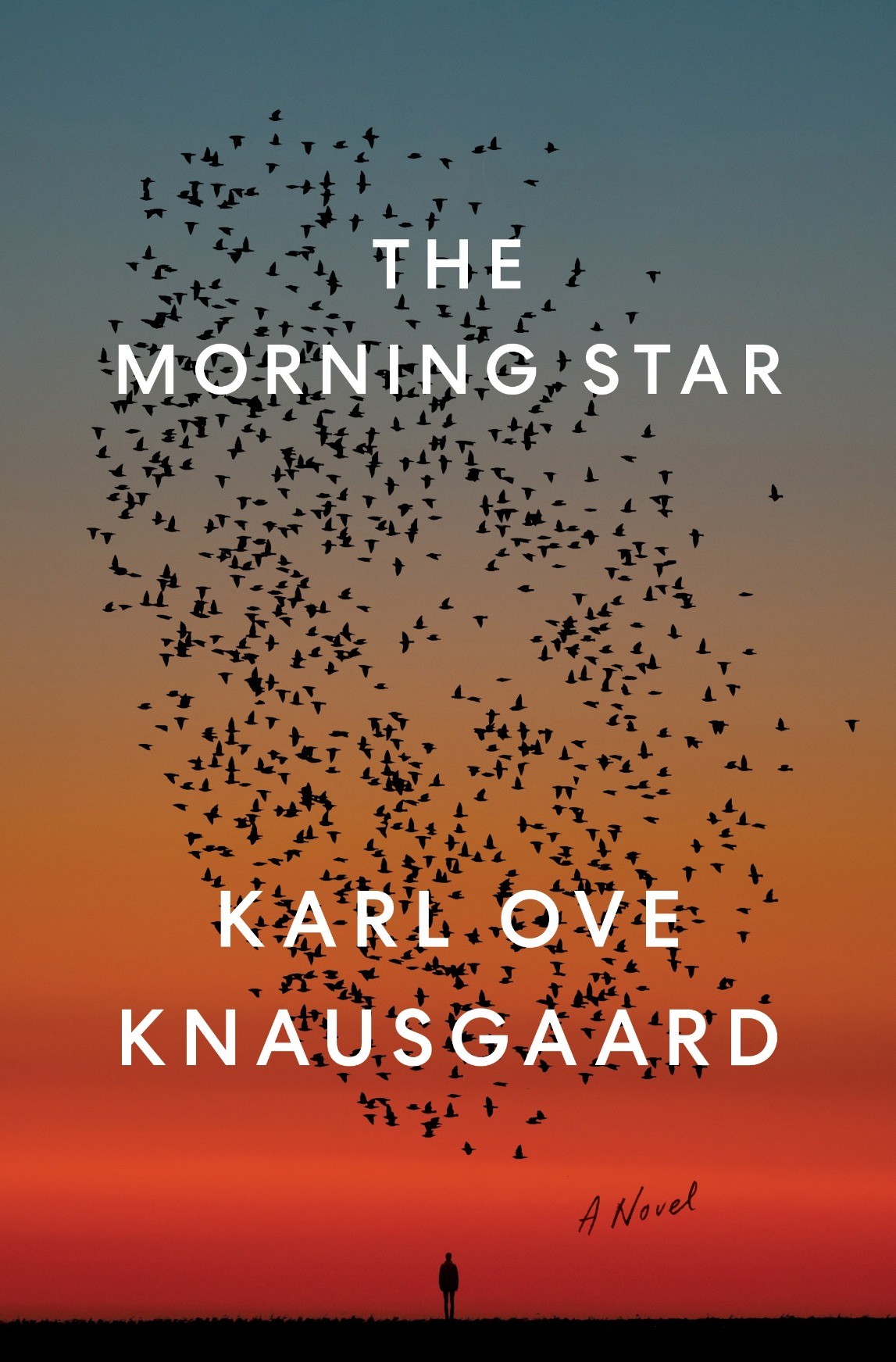A Book Review of Karl Ove Knausgaard’s The Morning Star

Whenever I finish reading a long novel at lightning speed, my immediate thought is that what I read was good because it held my attention so well. But maybe, having found it so hard to get back into reading after finishing my graduate degree in English literature, when I do find myself reading again, I scarf down the literature like a starving dog offered the blandest commercial pet food. Whether I was just hungering to get wrapped up in Karl Ove Knaugaard’s The Morning Star or found it genuinely and enjoyably captivating, I’m still unsure.
The Morning Star was an impulsive selection off the shelf at the Albuquerque Public Library. After lecturing myself about needing to read more contemporary fiction–to scratch a sociological if not literary itch to discover what people read nowadays–I thought, “Why not this?” In other words, it was an arbitrary decision.
I had heard of Knausgaard but had never read anything from his My Struggle autofiction series. I have no interest. Men’s autobiographical writing has never appealed to me, especially when so arrogantly titled.

Men’s writing in any genre doesn’t appeal to me. This statement isn’t misandrist for two reasons: First, misandry doesn’t exist, just like color blindness and racism against white people doesn’t exist. Second, general fatigue for narratives regarding a man’s struggle should have set in for all of us a while ago–it’s the rightful burden of having the most privileged and ubiquitous point of view.
We have been inundated with tales of men’s travails for millennia, from Odysseyus’s bachelor-esque boat-party adventure, to the passionate masochism of Christ, to Don Quixote’s windmill hunting, to Hamlet’s mopey theatrics, to Kafka’s cockroach drag . . . It’s not trite feminism to call out the Western canon of literature for being boring when we keep reproducing and glorifying the same things ad nauseam.
Well, “boring” isn’t exactly the right word. It’s hackneyed, and despite this, it is seductive as hell. We easily get caught up in meditations about the universal experiences that make us all human–affairs that survive the test of time and continue to shape the world and how we see ourselves. But therein lies the violence. This longstanding production of normativity has us believing that the struggle of the Eurocentric patriarch is the universal struggle. My struggle, which I hope is also our struggle, is having no place to escape this form of storytelling.

Speaking of being seductive as hell, The Morning Star is about the seduction of hell and reveries of the afterlife. As a mysterious new star appears in the sky over Norway, one of the characters reminds us that the Bible refers to Jesus and Satan alike as the “bright morning star.” With this thought in mind, the plot ambiguously unfolds around the uncertainty of this celestial event as either a harbinger of good or evil, life or death.
Considering that mad people and ghosts continuously warn the living “you are doomed” throughout the novel, we might conclude that things are not so good. But Knausgaard’s point, I think, is that these binaries of light/dark, good/evil, and heaven/hell are murkily intertwined in inscrutable ambivalence–which doesn’t make it any less cliche. This point is underscored by scenes of literal or metaphorical purgatory as the dying are stuck between life and death or characters simply disappear from the text, having no more “life” in the plot while existing somewhere off the page.

Knausgaard doesn’t hide his philosophical and theological preoccupations from his readers. We might even say he’s heavy-handed. The final chapter of the novel is an essay, “On Death and the Dead,” by the character Egil, a middle-aged documentary filmmaker. The book’s “Credits” serve as this essay’s bibliography as much as the novel’s, citing Aristotle, Kierkegaard, Nietzsche, and a few more great Western thinkers of death and its dance with life.
Man has surely been long interested in death, the devil, and the afterlife. We could cite Dante’s trip to hell in the Inferno, Bosch’s depictions of earthly sins that make the world itself look like hell, and sympathy for the devil in Milton’s Paradise Lost. Lars von Trier’s recent film The House that Jack Built is an homage to depictions of hell throughout the centuries. Hell has an undeniable literary-aesthetic appeal. It’s riveting stuff, making Knausgaard’s creepy and gory intervention into this conversation enthralling.
Yet, stepping back for perspective after reading the last page–which could not coincidentally be page 666–I wouldn’t argue that it’s a unique or necessary contemplation on these themes. And it lacks any obvious intellectual-theoretical innovation.
Rather than enticing us with novelty, the novel rehashes the traditional artistic and academic depictions of death and dying that we have always found intriguing. Moreover, it is very much obsessed with Man’s death. It doesn’t matter that many female characters focalize chapters in the novel or that Knausgaard is convincing when offering their perspectives. The parts women play at the onset of the apocalypse are engulfed in the universal idea of human experience, following the template of neoliberal Enlightenment thinking about who and what comprises the Human, which Leonardo da Vinci’s Vitruvian Man emblematizes. Visions of the devil and the afterlife spring directly from a history of Man’s contemplations of the end times.

Reading the blurbs on the back of the novel, critics triumph Knaugaard for his ability to capture the depth of the quotidian, glossing over the deeply supernatural focus of this book. They praise Kanusgaard for keeping us rapt by life’s banalities as if this novel were another installment of his autofiction.
Zadie Smith notes: “Every detail is put down without apparent vanity or decoration, as if the writing and living are happening simultaneously.” Jeffery Eugenides calls the novel “experimental,” adding that it underlines “the sheer sense of how amazing it is to be alive, on this planet and no other.” James Wood claims that the author gives “voice to universal anxieties” and that his spotlight on the ordinary is “momentous . . . because it happens in the course of a life, and happens, in different forms, to everyone.”
In other words, Knausgaard nails the universal human experience. However, to dispute Wood, he cannot master a form of universal storytelling and reveal how life “happens, in different forms,” to everyone at the same time. For Knausgaard, life seems to happen to various people in the same way, in the same place, at the same time. It’s hard to praise him for his diversity or for making the every day feel somehow new or extraordinary.

If the devil is in Knausgaard’s details, then the many characters who wipe their mouths with the backs of their hands after they have a “slurp” of beer and then leave to have a piss only contribute to a canned choreography that makes reality feel more like a simulation. Despite emphasizing the life of his characters by focusing on the impending doom of their deaths, Knausgaard creates characters that read like the undead, going through the same motions of ignorant, body-having mortality while unable to live meaningfully distinct lives.
Nevertheless, like a bafflingly addictive Netflix series, I stayed immersed in the humdrum world Knausgaard created despite his killing off more than one cat in it. By the end, I felt led by temptation into the depths of a Knausgaardian netherworld, uncertain if I was more annoyed at him or myself for this folly. Maybe Knausgaard himself is like Lucifer, a bright light you can’t look away from, suspending you between your opposing desires for something new and surprising, and old and familiar.
You can find a full list of my publications here.
Subscribe to my Substack here.

Leave a Reply